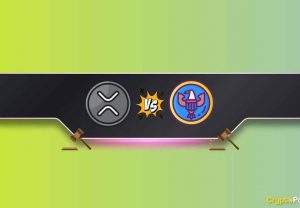
SET ALERTS
Sign up for alerts on the top ICOs.
-
Iran shows it can unleash its own deadly drone war against US troops
3 days ago -
13 innovative AI tools that are changing content creators’ work processes, from ideation to production to editing
3 days ago -

Sponge Token Price Rises 9% Despite Other Meme Coins Falling
4 days ago -

Important Ripple v. SEC Lawsuit Development
1 week ago -
The best budget gaming laptops in 2024
1 week ago
-

I Moved to El Salvador; Ask Me Anything
1 day ago -

Is Ripple (XRP) Price Ready to Catapult in February: These Analysts Chip in
1 day ago -

Positive Outlook on Sui for 2024, but Algotech (ALGT) Seems To Look More Promising
2 days ago -
Iran shows it can unleash its own deadly drone war against US troops
3 days ago -
13 innovative AI tools that are changing content creators’ work processes, from ideation to production to editing
3 days ago
Cryptocurrency
The best gaming monitors in 2023
When you buy through our links, Insider may earn an affiliate commission. Learn more
Insider
The best gaming monitors offer features that everyday office monitors lack, like extra low latency, HDR contrast, high refresh rates, and curved screens. The right display will help you make the most out of your gaming PC and can even improve your experience with consoles like the PS5 and Xbox Series X.
Our top pick is the LG 27GP850-B, which delivers a big 27-inch QHD screen, solid 165Hz refresh rate, and wide color support with high dynamic range. Buyers looking for a more budget-friendly option, should also consider the AOC C27G2Z. It can’t match the LG’s resolution or brightness, but it actually has a higher 240Hz refresh rate for less money.
Below, we’ve rounded up five of the best gaming monitors you can buy right now, covering a range of needs and budgets, including options for high-end performance, an ultrawide aspect ratio, and 4K gaming.
Here are the best gaming monitors of 2023
Best overall: LG UltraGear 27GP850-B – See at Amazon
This 27-inch 1440p monitor from LG has a well-rounded set of features and a great price, which help make it an ideal choice for most gamers, whether you need a single monitor or want to build a side-by-side setup.
Best budget pick: AOC C27G2Z – See at Amazon
AOC’s 27-inch 1080p monitor features a curved screen and offers an impressive 240Hz refresh rate at an affordable price, making it a quality choice for competitive gamers on a budget.
Best high-end 1440p model: Asus ROG Swift PG27AQDM – See at Amazon
This premium 1440p monitor uses a 27-inch OLED panel to deliver better contrast than other display types, along with impressive HDR capabilities, a 240Hz refresh rate, full G-Sync compatibility, and anti-glare coating.
Best ultrawide: LG UltraGear 45GR95QE-B – See at Best Buy
Designed with an ultrawide 1440p screen, this 45-inch curved OLED monitor will give your PC setup a cinematic feel. It also offers picture-in-picture support so you can split the large screen between a gaming PC and another device.
Best for 4K gaming: Samsung Odyssey Neo G8 – See at Amazon
Samsung’s Odyssey Neo G8 is a 32-inch curved display that offers 4K resolution and a fast 240Hz refresh rate. It also boasts HDMI 2.1 connectivity, which makes it a great fit for PS5 and Xbox Series X/S.
Amazon
Pros: Solid HDR brightness, responsive, affordable
Cons: Struggles with contrast, no HDMI 2.1 ports
Thanks to its excellent balance between cost and value, this 27-inch UltraGear display from LG is our top pick for the best gaming monitor. It’s straightforward in its design but provides everything you could ask for as a PC gamer while maintaining a great price point.
The 1440p IPS LCD panel is incredibly responsive, offers great color accuracy, around 400 nits of brightness with HDR support, and a wide viewing angle. However, it struggles with contrast in comparison to newer monitors using OLED or VA LCD panels.
The display supports variable refresh rate with G-Sync and FreeSync compatible graphics cards, with a maximum refresh rate of 165Hz. While other monitors offer higher refresh rates, 165Hz is plenty for PC gaming and more than enough for consoles.
Just keep in mind that you’ll need to use the monitor’s DisplayPort connection to get 1440p at 165Hz, since its HDMI 2.0 ports can’t support that combination. The HDMI ports will support up to 1440p at 120Hz when connected to a PS5 or Xbox Series X, however, which is a nice perk for console gamers.
The thin bezel and adjustable stand are great for building an affordable set of side-by-side monitors, and the screen can be pivoted into portrait mode. While there are cheaper versions of this monitor, they lack key features (like this version’s two USB 3.0 ports) and use dimmer panels that aren’t bright enough for proper HDR contrast and color.
AOC
Pros: Fast refresh rate at an affordable price
Cons: Limited to 1080p resolution, can’t support true HDR
AOC’s C27G2z is a 27-inch curved monitor that carries a very affordable price tag while still offering a fast refresh rate. It’s a great choice for competitive gamers who want to improve their reaction times as well as casual players on a budget. The 240Hz refresh rate is relatively unheard of at this price point, though the monitor’s 1080p resolution is not ideal.
Gamers playing fast-paced titles at high frame rates will benefit the most from the refresh rate and be less impacted by the lower resolution. Console gamers who are used to 4K TVs may be initially disappointed with the 1080p limit, but the monitor is still capable of playing PS5 and Xbox games at 120Hz.
The monitor uses a VA LCD panel, helping it deliver deep contrast, but it doesn’t support true HDR processing like some of our other picks. Instead, it has modes that can simulate the look of HDR. The curve is graded at 1500R, meaning it’s closer to a flat panel than monitors from other brands like Samsung, which may or may not be a pro depending on your preferences
Though the monitor doesn’t have speakers or USB ports for extra inputs, it does have a headphone jack for audio out. Considering its price, the AOC C27G2z delivers impressive features for the money, and should suit most buyers looking for a reliable gaming monitor that doesn’t break the bank.
Asus
Pros: OLED display with exceptional contrast, high-end HDR performance, fast refresh rate
Cons: High starting price, no HDMI 2.1, some risk of burn-in with OLED technology
This version of the Asus Rog Swift was one of the first OLED gaming monitors to hit the market; OLED display technology is great for gaming thanks to its fast response times and infinite contrast ratio. This translates into sharp HDR color and deep blacks compared to backlit LCD monitors that can appear washed out or slightly gray.
The Asus Rog Swift checks all the boxes in terms of performance too, running at 1440p with a 240Hz refresh rate and G-Sync support to minimize screen tearing and stuttering. The display reaches a peak brightness of 1,000 nits, which is well over the minimum recommended spec of 400 for HDR on a monitor. It’s also equipped with an anti-glare coating to prevent reflections and protect picture quality.
On the downside, the Asus Rog Swift uses older HDMI 2.0 ports, which cannot support signals beyond 1440p resolution at 144Hz. This is fine for playing PS5 and Xbox Series X at 120Hz, but PCs with support for higher refresh rates will need to use the monitor’s sole DisplayPort connection in order to unlock full 1440p/240Hz support.
But all things considered, the Rog Swift is simply gorgeous, with high-end image performance that offers a noticeable upgrade over our less expensive picks. This is the best PC gaming monitor you can buy if you want a premium 1440p experience.
Best Buy
Pros: Wide aspect ratio for a cinematic feel, OLED display with vibrant colors and high contrast, HDMI 2.1 ports, picture-in-picture mode
Cons: Screen might be too large for some setups, ultrawide aspect ratio isn’t supported on all games, OLED tech has some risk of burn-in
LG’s 45-inch UltraGear monitor has an impressive OLED panel and a deep 800R curve that makes it easier to see the edges of its large ultrawide screen without turning your head. The 1440p OLED panel provides outstanding color and contrast, and the UltraGear 45GR95QE-B is fully equipped with features to help prevent burn-in too.
The monitor is G-Sync certified and can reach a 240Hz refresh rate whether connected via DisplayPort or its HDMI 2.1 ports. It can also accept a 4K/120Hz signal from a PS5 of Xbox Series X, but it will need to downscale that signal to 1440p.
Ultrawide monitors provide a wider field of view in compatible games, whether that’s more space on the map, or more vision behind the wheel of a car. Common PC titles like racing, strategy, and role playing games support ultrawide aspect ratios, but games designed with consoles in mind, like Elden Ring, might be limited to 16:9. If a game doesn’t support the wide ratio, you’ll see black bars on the left and right of the image.
Despite its size, the UltraGear OLED doesn’t have speakers; it comes with a standard headphone jack, a digital audio out port, and supports DTS Headphone:X surround sound instead. There are two USB 3.0 ports to connect devices as well.
The monitor includes picture-in-picture support, so you can split the screen between multiple devices while multitasking. This is particularly useful for such a large screen, since most computer desks won’t have space for a second display alongside this 45-inch behemoth.
You also get a remote for easy control, including programmable buttons for specific settings. However, the display lacks on-board buttons for power and changing the input. While the remote is responsive and makes sense for such a large monitor, basic controls on the bezel would be nice to have.
If 21:9 isn’t wide enough for you, LG also makes a 49-inch non-OLED alternative with a 32:9 aspect ratio, giving you the same amount of desktop space as two side-by-side monitors, but on a single display.
Samsung
Pros: Excellent HDR performance, high refresh rate at 4K, two HDMI 2.1 ports for PS5 and Xbox Series X
Cons: Expensive base price, 1000R curve may require an adjustment period for some users
The Samsung Odyssey Neo G8 is the first monitor to boast both a 4K native resolution and a 240Hz refresh rate. It also has two HDMI 2.1 ports that offer full 4K/120Hz compatibility with PS5 and Xbox Series X/S consoles. The 32-inch screen has a deep curve of 1000R and can be fully rotated between portrait and landscape mode.
The Neo G8 uses a VA LCD panel with a Mini LED backlight and local dimming. This enables the display to reach an incredible peak brightness of 2,000 nits in HDR mode while offering better contrast control than a typical VA monitor. It’s a great benefit compared to gaming monitors that struggle to reach the minimum suggested HDR brightness of 400 nits. The contrast is impressive as well, though it’s not quite as good as some newer OLED displays.
The monitor even supports HDR10+, an advanced high dynamic range format that helps compatible movies and games produce even more accurate contrast levels and colors. G-Sync and FreeSync are supported as well, so variable refresh rate should work well regardless of your graphics card.
On the downside, the steep curve of the Neo G8 may not be ideal for those who multitask; widescreen movies can appear a bit warped at the edges due to the curve and it can also make normal documents and web pages seem slightly curved as well.
However, for those looking to game at full 4K resolution, the Neo G8 is a beast of a display. The monitor’s combination of a high-resolution screen, fast refresh rate, and bright HDR performance easily make it a top pick.
Best Buy
We picked the best gaming monitors based on a combination of hands-on testing and extensive research. When we test gaming monitors, we evaluate them for everyday and specific gaming criteria to test the limits of a monitor’s features and performance.
Everyday use includes both gaming and standard work tasks performed in Windows, like photo editing, web browsing, and writing using common applications like Microsoft Office. We also evaluate a monitor’s physical build to determine whether it takes up too much space on an average desk, or if it wobbles too much when using the on-board controls.
Gaming-centric evaluations include testing a monitor’s variable refresh rate, HDR color and contrast, and brightness using in-game benchmarks from titles like Red Dead Redemption 2 and Assassin’s Creed Valhalla. This helps judge a monitor’s accuracy in common settings, and can also help identify issues like ghosting or screen tearing.
Finally, our recommendations also consider the overall value of each monitor based on their price. While the best gaming monitors are made with a wide range of budgets in mind, we highlight monitors that give gamers the most for their money, so we won’t recommend cheap monitors that lack essential features, or expensive monitors that are out-performed by more affordable models.
LG
What size is best for a gaming monitor?
The ideal size for your gaming monitor mostly depends on how far you plan to sit from your computer and what types of games you plan to play. For example, competitive gamers should opt for 24 or 27-inch monitors, because they tend to sit relatively close to the screen and can benefit from the higher refresh rates that are typically available on monitors of that size. Players who prefer adventure games or immersive sports and racing simulations can opt for larger monitors that rival TV sizes at 32-inches and above.
Our recommendation is to measure the distance from your usual gaming seat to your screen; if it’s two feet or less we recommend a 27-inch monitor or smaller, but if you’re further than two feet away, go for a 32-inch monitor or larger.
Are curved monitors better?
Some of the best gaming monitors are curved to provide a better viewing angle; this can be helpful when sitting close to large screens. However, a curved screen alone won’t make the picture appear better. Some people may prefer a standard flat screen for tasks like photo and video editing, to ensure the monitor’s curve doesn’t distort their perception of on-screen images.
Monitor curves are measured based on their radius; the smaller the radius, the deeper the curve in the monitor. So, a 1000R monitor is more curved than a 1500R monitor.
What resolution is best for a gaming monitor?
The best resolution for your monitor will ultimately depend on your PC or console and what games you like to play. PlayStation 5 and Xbox Series consoles are designed to output at 4K resolution, while the Nintendo Switch maxes out at 1080p. For PC gamers, resolution will depend on the strength of your graphics card. Most computers can run games at 1080p, while the best gaming PCs and best gaming laptops will have the power to run at 1440p and even 4K.
Higher resolution typically means more visual detail, so you’ll usually want to run at the highest option possible. Some competitive gamers prefer to limit their resolution to 1080p so that gameplay runs at a higher frame rate, which can reduce delay and improve reaction times.
How does refresh rate impact a gaming monitor?
Refresh rate denotes how many times a display updates the image you see on-screen per second; a 60Hz monitor will display 60 individual frames per second, while a 144Hz monitor will show 144 frames per second, and so on.
Generally, higher refresh rates make animations appear smoother and you’ll experience less delay when trying to react to things on screen, especially if your gaming PC can run games faster than 60 frames per second.
Refresh rate is also slightly less important with consoles, because they’re designed to work with TVs with lower refresh rates, and games are often locked to 60 or 30 frames per second. PlayStation 5 and Xbox Series X are capable of playing some games at 120Hz with variable refresh rate, while the Nintendo Switch is limited to 60Hz and has no VRR support.
On the low end, the best gaming monitors tend to start at a refresh rate of 144Hz, while premium models can have refresh rates as high as 360Hz.
How do variable refresh rate (VRR), AdaptiveSync, and G-Sync work?
Variable refresh rate (VRR) is a feature that works to match your PC or console’s frame rate with the monitor’s refresh rate, which prevents screen tearing or other issues that can arise when the frame rate and refresh rate aren’t even.
Adaptive Sync is a general term used to describe VRR compatibility. G-Sync is a version of VRR technology that works specifically with graphics cards from Nvidia, while AMD graphics cards call their VRR tech FreeSync. The Adaptive Sync feature is still designed to work with graphics cards from Nvidia and AMD, even if the monitor isn’t fully G-Sync or FreeSync certified.
Do gaming monitors include speakers?
Some gaming monitors do include speakers, which can be convenient if you don’t have a separate set of speakers and you prefer to game without headphones. However, the quality of most computer monitor speakers usually isn’t worth the extra money; in fact, you’re better off buying an affordable set of PC speakers for $60 or less.With that in mind, none of our picks for the best gaming monitors include built-in speakers.
What are the different type of gaming monitor displays?
Gaming monitors use a range of different display technologies, including four major types of panels: TN, IPS, VA, and OLED.
The first three types — TN, IPS, and VA — are all LCD-based display technologies and they have big similarities. OLED, meanwhile, uses an entirely different panel technology and offers the most striking improvements.
TN stands for twisted nematic; it’s the most common LCD panel type and offers faster refresh rates at a lower cost than the alternatives. IPS stands for in-plane-switching, and these displays offer great color accuracy and wide viewing angles. VA stands for vertical alignment, and LCDs of this type are known excellent contrast ratios and brightness, but can struggle with refresh rates.
OLED, which stands for organic light emitting diode, has the best image quality and viewing angles of the bunch. This is because OLED screens have pixel-level contrast control rather than a backlight. However, OLED gaming monitors are by far the most expensive display type, and there is some risk of burn-in associated with OLED displays under extreme viewing conditions.

